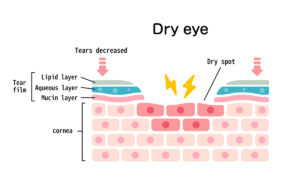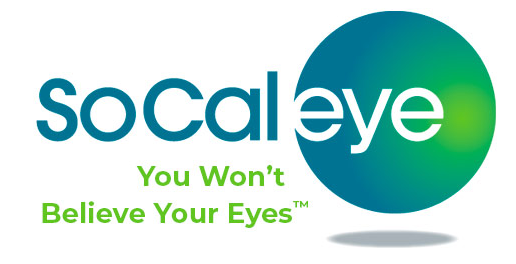SoCal Eye – Dry Eye Specialists In Long Beach
It is estimated that 20% of the US population suffer from Dry Eye Disease (DED) or Dry Eye Syndrome. Though the condition is not associated exclusively with aging, its prevalence increases in patients over the age of 40. DED patients who experience dry, gritty or scratchy eyes or increased sensitivity to wind or air conditioning may suffer from a condition that is very treatable with experienced medical attention. SoCal Eye Ophthalmology are Dry Eye Specialists in Long Beach, Huntington Beach and Garden Grove. Schedule an Appointment today at LAKEWOOD (562) 531-2020 | LOS ALAMITOS (562) 598-7728 or send us an Online Consultation Request
What Is Dry Eye Disease?
Dry Eye Disease is a chronic eye condition that occurs when the eyes do not produce enough or the right kind of tears to provide sufficient lubrication. Tears or tear film cover the eye during blinking and keep the surface smooth and clear. The tear film is important for comfortable, healthy eyes. Insufficient lubrication of the eye leads to inflammation and damage of the eye’s surface and discomfort. The sensations can range from stinging and burning to a scratchy/gritty feeling synonymous with a foreign body being caught in the eye.
In some case DED is caused by inadequate tear production (Aqueous Tear Deficiency – ATD) characterized by low tear volume or by tears that are not produced in the right consistency and break up too quickly (Evaporative Dry Eye – EDE)
Tears are produced in various parts of the eye and are made up of three layers. Each represents a potential cause for Dry Eye Disease and a focus of treatment:
- Lipid layer: The outer oily layer of the tear film that keeps the surface smooth and prevents the tear from drying too quickly. This is produced by the Meibomian Glands in the eye.

- Aqueous layer: The middle watery layer of the tear makes up the largest amount of the tear volume. This component washes the surface of the eye to remove particles and is produced in the Lacrimal Glands in the EyeLids.
- Mucin layer: This layer of mucus is responsible for the tears sticking to the eye surface and allows the tears to be spread evenly. This produced in the Conjunctiva.
Dry Eye Disease Causes & Risk Factors:
Dry eyes can develop for many reasons and in a number of cases can be as a result of more than one factor. It is important to conduct an in depth review of all possible causes to ensure the right treatment.
Age:
Dry eyes are a most commonly associated with hormonal changes that occur with the natural aging process. The majority of people over age 65 experience symptoms of dry eyes.
Gender:
Both men and women can get dry eye but it is more prevalent in women. Hormonal changes caused by pregnancy, the use of oral contraceptives and menopause increase the frequency amongst women. .
Medication:
Reduced tear production can be traced to certain medicines.
- Diuretics (water pills) for high blood pressure
- Beta-blockers, for heart problems or high blood pressure
- Allergy and cold medicines (antihistamines)
- Sleeping pills
- Anxiety and antidepressant medicines
- Heartburn medicines
Medical Conditions:
Underlying medical conditions can cause Dry Eye Disease.
- People with Rheumatoid arthritis, Sjögren’s syndrome, diabetes, and thyroid problems are more likely to experience symptoms of dry eyes.
- Blepharitis/Entropion/Ectropion. Eyelid conditions that cause the inflammation of the eyelid or inward/outward turning of the eyelids.
Environmental Conditions:
Exposure to environmental conditions that result in failure to blink or increased blinking can contribute to Dry Eye. Excessive screen time on electronic devices reduces blinking and less blinking allows more time for tears to evaporate. Increased exposure to smoke (smoking) or wind particularly in dry climates like California can increase tear production and increase tear evaporation resulting in dry eye symptoms.
Other Factors:
Long-term use of contact lenses can be a factor in the development of dry eyes. Refractive eye surgeries, such as LASIK, can decrease tear production and contribute to dry eyes.
Dry Eye Symptoms & Detection:
Symptoms:
Dry Eye Disease Symptoms are usually related to discomfort rather than vision loss. People with dry eyes may experience irritated, gritty, scratchy or burning eyes; a feeling of something in their eyes; and potentially blurred vision when reading. The eyes can become irritated, red and inflamed and can make the wearing of contact lenses difficult and painful. Sometimes patients experience excessive watering and a build-up of mucus in or around the eye.
Detection:
Dry Eye is diagnosed with a comprehensive eye examination. Further analysis and testing is performed to evaluate the quantity and quality of tears produced by the eyes and ascertain causation.
- Questionnaire: The medical history, medication schedule and potential environmental exposures are reviewed for contributing factors.
- Eye Exam: External examination and evaluation of the eye, including eyelids, blinking and the cornea under bright light and magnification.
- Measurement of the quantity and quality of tears using special dyes. These dyes will help the Dry Eye Specialist to identify abnormalities in makeup of tears and also issues related to the spreading of the tears across the eye.
Dry Eye Treatment:
Treatments for dry eye aim to either manage the symptoms and relieve discomfort, increase tear production, or treat the inflammation of the eyelids or eye surface that contributes to the dry eyes.
Artificial Tears/ Eye Drops:
In the majority of cases dry eye can be managed using over-the-counter artificial tear solutions. It is best to use preservative-free artificial tear solutions which contain fewer additives. Artificial tears bring temporary relief to many of the symptoms and may be all that is needed. Conditions that don’t respond to artificial tears alone will need to take additional treatment options.
Closing Tear Ducts:
Retention of natural tears in the eyes longer can reduce the symptoms of dry eyes. Tear ducts can be closed with the implantation of removable silicone or gel-like plugs or a surgical procedure can permanently close the tear ducts.
EyeLid Massage/Therapy:
A procedure using intense-pulsed light therapy followed by massage of the eyelids has proved to help people with severe dry eyes.
SoCal Eye Dry Eye Consultation:
Dry Eye is a common eye condition that can create discomfort and reduce the quality of life. The key to success with Treatment for Dry Eye is a comprehensive eye exam and diagnosis by a dry eye specialist. SoCal Eye doctors are the Dry Eye Specialists in Long Beach. Schedule an Appointment today at LAKEWOOD (562) 531-2020 | LOS ALAMITOS (562) 598-7728 or send us an Online Consultation Request




